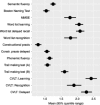A Longitudinal Item Response Theory Model to Characterize Cognition Over Time in Elderly Subjects
- PMID: 28643388
- PMCID: PMC5613212
- DOI: 10.1002/psp4.12219
A Longitudinal Item Response Theory Model to Characterize Cognition Over Time in Elderly Subjects
Abstract
For drug development in neurodegenerative diseases such as Alzheimer's disease, it is important to understand which cognitive domains carry the most information on the earliest signs of cognitive decline, and which subject characteristics are associated with a faster decline. A longitudinal Item Response Theory (IRT) model was developed for the Basel Study on the Elderly, in which the Consortium to Establish a Registry for Alzheimer's Disease - Neuropsychological Assessment Battery (with additions) and the California Verbal Learning Test were measured on 1,750 elderly subjects for up to 13.9 years. The model jointly captured the multifaceted nature of cognition and its longitudinal trajectory. The word list learning and delayed recall tasks carried the most information. Greater age at baseline, fewer years of education, and positive APOEɛ4 carrier status were associated with a faster cognitive decline. Longitudinal IRT modeling is a powerful approach for progressive diseases with multifaceted endpoints.
© 2017 The Authors CPT: Pharmacometrics & Systems Pharmacology published by Wiley Periodicals, Inc. on behalf of American Society for Clinical Pharmacology and Therapeutics.
Figures
References
-
- World Alzheimer Report . The global impact of dementia. <http://www.alz.co.uk/research/world‐report‐2015> (2015).
-
- Ito K., Ahadieh S., Corrigan B., French J., Fullerton T. & Tensfeldt T. Disease progression meta‐analysis model in Alzheimer's disease. Alzheimers Dement. 6, 39–53 (2010). - PubMed
-
- Ito K., et al Disease progression model for cognitive deterioration from Alzheimer's Disease Neuroimaging Initiative database. Alzheimers Dement. 7, 151–160 (2011). - PubMed
Publication types
MeSH terms
Substances
LinkOut - more resources
Full Text Sources
Other Literature Sources



